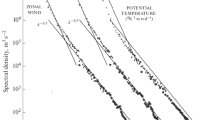Abstract
Stochastic models can generate profiles that resemble topography by taking uncorrelated, zero-average noise as input, introducing some correlation in the time series of noise, and integrating the resulting correlated noise. The output profile will depict a nonstationary, randomly rough surface. Two models have been chosen for comparison: a fractal model, in which the noise is correlated even at large distances, and an autoregressive model of order 1, in which the correlation of the noise decays rapidly. Both models have as an end-member a random walk, which is the integration of uncorrelated noise. The models have been fitted to profiles of submarine topography, and the sample autocorrelation, power spectrum and variogram have been compared to the theoretical predictions. The results suggest that a linear system approach is a viable method to model and classify sea-floor topography. The comparison does not show substantial disagreement of the data with either the autoregressive or the fractal model, although a fractal model seems to give a better fit. However, the amplitudes predicted by a nonstationary fractal model for long wavelengths (of the order of 1000 km) are unreasonably large. When viewed through a large window, ocean floor topography is likely to have an expected value determined by isostasy, and to be stationary. Nonstationary models are best applied to wavelengths of the order of 100 km or less.
Similar content being viewed by others
References
Berry, M. V., andHannay, J. H. (1978),Topography of Random Surfaces, Nature273, 573.
Box, G. E. P., andJenkins, G. M.,Time Series Analysis, Forecasting and Control, (Holden-Day, San Francisco 1970).
Brown, S. R., andScholz, C. H. (1985),Broad Bandwidth Study of the Topography of Natural Rock Surfaces, J. Geophys. Res.90, 12575–12582.
Burrough, P. A. (1981),Fractal Dimensions of Landscapes and Other Environmental Data, Nature294, 240–242.
Chayes, D. N. (1973),Evolution of Sea MARC I, IEEE Proc. of the third working Symposium on Oceanographic Data Systems 103-108.
Fox, C. G., andHayes, D. E. (1985),Quantitative Method for Analyzing the Roughness of the Sea-floor, Rev. Geophys. Space Phys.23, 1–48.
Hammond, S. R., Malahoff, A., Embley, R. W., Currie, R. G., Davis, E. E., Riddihough, R. P., andSawyer, B. S.,Preliminary Seabeam Bathymetry of the Juan de Fuca Ridge (Earth Physics Branch, EMR, Open File Report 84-6, Canada 1984).
Journel, A. G., andHuijbregts, Ch. J.,Mining Geostatistics (Academic Press, New York 1978).
Mandelbrot, B. B., (1967),How Long is the Coast of Britain? Statistical Self-similarity and Fractional Dimension, Science156, 636–638.
Mandelbrot, B. B.,The fractal Geometry of Nature (W. H. Freeman and Company, New York 1983).
Mandelbrot, B. B., andVan Ness, J. W. (1968),Fractional Brownian Motions, Fractional Noises and Applications, SIAM Review10, 422–437.
Mandelbrot, B. B., andWallis, J. R. (1969),Computer Experiments with Fractional Gaussian Noises, Water Resources Res.5, 228–267.
McKenzie, D. P. (1967),Some Remarks on Heat Flow and Gravity Anomalies, J. Geophys. Res.72, 6261–6273.
Parker, R. L., andOldenburg, D. W. (1973),Thermal Model of Ocean Ridges, Nature Phys. Sci.242, 137–139.
Parsons, B., andSclater, J. G. (1977),An Analysis of the Variation of Ocean Floor Bathymetry and Heat Flow with age, J. Geophys. Res.82, 803–827.
Voss, R. F.,Random fractal forgeries, InFundamental Algorithms for Computer Graphics, NATO ASI Series, Vol. F17 (ed. Earnshaw, R. A.) (Springer-Verlag, Berlin Heidelberg 1985) pp. 805–835.
Author information
Authors and Affiliations
Rights and permissions
About this article
Cite this article
Malinverno, A. Testing linear models of sea-floor topography. PAGEOPH 131, 139–155 (1989). https://doi.org/10.1007/BF00874484
Received:
Revised:
Accepted:
Issue Date:
DOI: https://doi.org/10.1007/BF00874484




